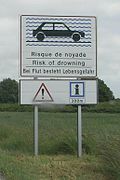
The Passage du Gois (French pronunciation: [pasaʒ dy ɡwa]) or Gôa is a causeway between Beauvoir-sur-Mer and the island of Noirmoutier, in Vendée on the Atlantic coast of France. The causeway is 4.125 kilometres (2.6 mi) long and is flooded twice a day by the high tide. A road runs along the causeway.
Every year, a foot race – the Foulées du Gois – is held across it, starting at the onset of high tide.
Tour de France
The Passage du Gois was used in Stage 2 of the 1999 Tour de France bicycle race. It proved to be divisive due to a crash caused by the slippery surface. The crash created a six-minute split in the peloton which ended the hopes of many favourites to win the race, including Alex Zülle, who would eventually finish second overall.
The Passage du Gois was used again in the 2011 race, as the starting point of the first stage.
See also
- Île de Noirmoutier
- The Broomway, a similar causeway to Foulness Island in Essex, England
46°55′51″N 2°07′34″W / 46.93083°N 2.12611°W / 46.93083; -2.12611
References
- "Le Passage du Gois". Beauvoir sur Mer (in French). Mairie de Beauvoir sur Mer. Archived from the original on 2015-07-06. Retrieved 2015-07-07.
- "Passage du Gois". Retrieved 20 September 2021.
- "1999 Tour de France stage two: Passage du Gois causes chaos". Cycling Weekly. 30 June 2011. Retrieved 20 September 2021.
- "Passage du Gois, team time trial back for 2011 Tour". VeloNews. Retrieved 20 September 2021.




